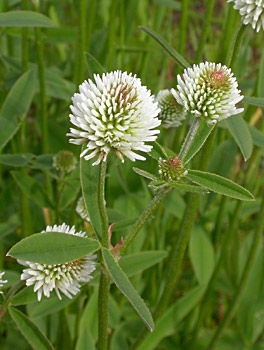Relatives
Trifolium montanum L. - Mountain Clover
Taxonomic position.
Family Leguminosae Endl., genus Trifolium L.Biology and morphology.
This is a perennial herb, 20 to 60 cm tall with few to many erect or ascending hairy or hairless stems arising from a thickened root. Stipules are about 1 cm long, papery, attached to the stem most of the length, the free portion ovate with slender tip, those of the lower leaves long and sheathing the stem. Lower leaves with long stalks are about 10-20 cm long, the middle and upper ones short-stalked to having almost no stalks and widely spaced along the stem. Leaflets are 2 to 10 cm long, 0.8 to 2.5 cm wide, elliptical, ovate or oblong to lance-shaped, leathery, blunt or pointed with a small pointed tip, hairy or not, prominently veined, rounded or tapered slightly at the base, the margin finely toothed. Heads are 1.5 to 2.0 cm in diameter, round to ovoid, elongating after flowering, usually with a single terminal head and often with 1 or 2 heads born in the axils of the leaves below, on stalks 4 to 15 cm long. Flowers are 7-9 mm long, calyx 6 to 8 mm long, bell-shaped, sparingly hairy or not, the tube ten-veined, whitish, the teeth equal or slightly longer than the tube, equal to one another or nearly so, awl-like at the tip. Corolla reaches 0.9 cm long, white or yellowish, rarely pink. Pods are 4 to 6 mm long, ovoid to oblong, slightly oblique, with short persistent style, 1- to 2- seeded. The flowering period occurs from June to August. Self-incompatible, cross-pollinated mainly by honey bees. Chromosome: 2n=16.Distribution.
The species grows form the European part of the former USSR (all regions, more rarely at the north), Crimea (mountain part), Caucasus, Western Siberia, Kazakhstan (the most northern and north-western regions).Ecology.
It grows often on dry calcareous and sandy soils. It also grows in dry meadows, forest clearings, steppes, grassy places and mountain slopes at 1800 to 2400 m above sea level.Utilization and economic value.
This species can be used as a forage crop for pasture and hay for wood and hill habitats. This species is characterized by fast re-growth after cutting. Some of the disadvantages of this plant are that it has large coumarin content in its leaves and also a hairiness that reduces the palatability by animals. It is a good melliferous plant.Reference citations:
Brezhnev D.D., Korovina O.N. 1980. Wild relatives of the cultivated plants of flora of the USSR. Leningrad: Kolos. 376 pp. (In Russian)Galushko, A.I. 1980. Flora of Northern Caucasus. A field guide. V. 2. Rostov-na-Donu. 350 pp. (In Russian)
Grossheim, A.A. 1952. Genus Trifolium. Flora of the Caucasus. V. 5. Moscow-Leningrad: AN USSR. 191-221 p. (In Russian)
Kolakovskiy, A.L. 1958. Flora of Abhasiya. V. 3. Tbilisi. 292 pp. (In Russian)
Mosel H. 1965. Comparative Chorology of the Flora of Central Europe. Jena. 583 p.
Mukhina, N.A. & A.K. Stankevich, ed. 1993. Flora of cultivated plants. Trifolium, Lotus. V. 13. Moscow: Kolos. 334 pp. (In Russian)
Pavlov, N.B., ed. 1961. Flora of Kazakhstan. V. 5. Alma-Ata: AN KazSSR. 515 pp. (In Russian)
Phyodorov, A.A., ed. 1987. Flora of the European part of the USSR. V. 6. 254 pp. (In Russian)
Polozhiy, A.B. & L.I. Malyshev, ed. 1994. Flora of Siberia. V. 9. Novosibirsk: Nauka. 280 pp. (In Russian)
Schischkin, V.K. & E.G. Bobrov, ed. 1945. Flora of the USSR. V. 11. Moscow-Leingrad: AN USSR. 129-176 p. (In Russian)


